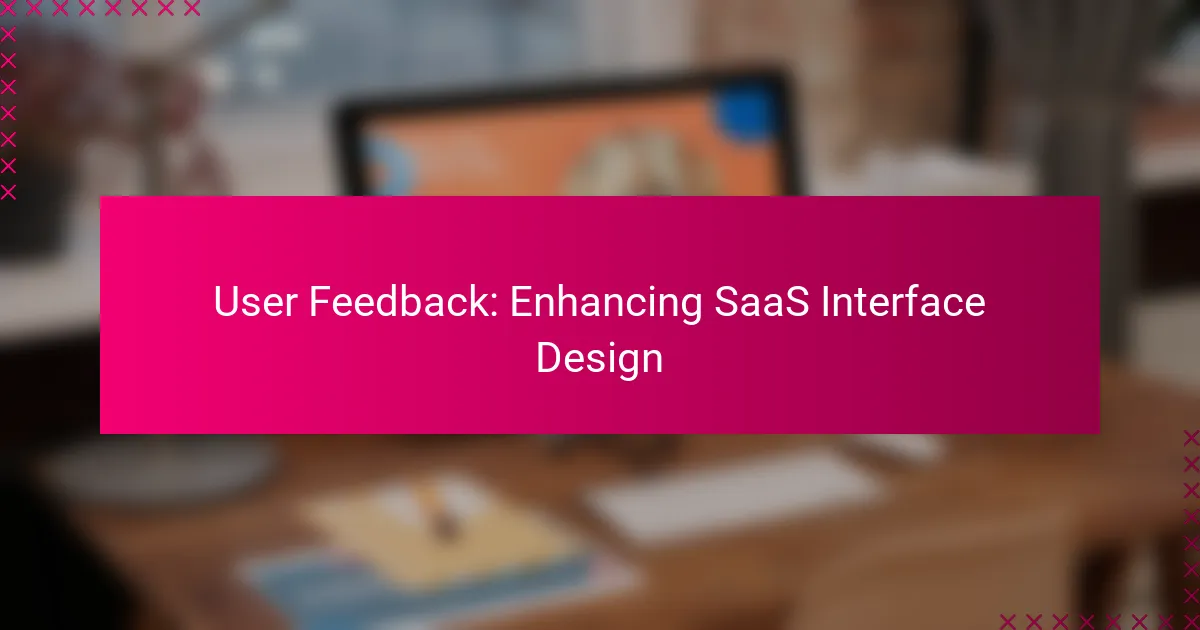User feedback plays a vital role in refining SaaS interface design, offering valuable insights into user needs and challenges. By leveraging methods such as surveys and usability testing, companies can gather essential data that informs design improvements, ultimately enhancing the overall user experience.

How can user feedback improve SaaS interface design in the UK?
User feedback is crucial for enhancing SaaS interface design in the UK, as it provides direct insights into user preferences and pain points. By systematically gathering and analyzing this feedback, companies can make informed design decisions that lead to better user experiences.
Increased user satisfaction
Incorporating user feedback can significantly boost user satisfaction by aligning the interface with user expectations. When users feel that their opinions are valued and reflected in the design, they are more likely to enjoy using the software.
For example, regularly conducting surveys or usability tests can reveal specific features that users appreciate or dislike. This allows designers to prioritize changes that enhance overall satisfaction.
Enhanced usability
User feedback directly contributes to improved usability by identifying areas where users struggle. By observing how users interact with the interface, designers can pinpoint confusing elements and streamline navigation.
Implementing changes based on feedback, such as simplifying menus or clarifying instructions, can lead to a more intuitive experience. Tools like A/B testing can also help determine which design variations perform better in terms of usability.
Higher retention rates
Utilizing user feedback can lead to higher retention rates by creating a product that meets user needs effectively. When users find the interface easy to use and responsive to their feedback, they are more likely to continue using the service over time.
To maximize retention, SaaS providers should establish a continuous feedback loop, allowing for ongoing improvements. Regular updates based on user input can keep the interface fresh and engaging, encouraging users to remain loyal to the product.

What are effective methods for collecting user feedback?
Effective methods for collecting user feedback include surveys, user interviews, and usability testing. These approaches help gather insights directly from users, enabling improvements in software as a service (SaaS) interface design.
Surveys and questionnaires
Surveys and questionnaires are structured tools for collecting user feedback, often delivered online. They can include multiple-choice questions, rating scales, and open-ended responses, allowing for quantitative and qualitative data collection.
To maximize response rates, keep surveys concise, ideally under 10 questions, and consider incentivizing participation with discounts or small rewards. Use clear language and avoid jargon to ensure users understand the questions.
User interviews
User interviews provide in-depth insights through direct conversations with users. This method allows for probing questions and follow-ups, helping to uncover motivations and pain points that may not surface in surveys.
When conducting interviews, aim for a diverse range of participants to capture various perspectives. Prepare a semi-structured guide to keep discussions focused while allowing flexibility for deeper exploration of topics.
Usability testing
Usability testing involves observing users as they interact with your SaaS interface to identify usability issues. This method can reveal how intuitive the design is and highlight areas for improvement based on real user behavior.
Conduct usability tests with a small group of users, typically 5-10, to gather actionable insights. Focus on specific tasks and encourage users to think aloud, providing context for their actions and decisions.

Which tools facilitate user feedback collection?
Several tools effectively facilitate user feedback collection, allowing SaaS companies to gather insights on their interface design. These tools help streamline the process of obtaining user opinions, preferences, and experiences, which can significantly enhance product usability.
Typeform
Typeform is an interactive survey tool that allows users to create engaging questionnaires. Its user-friendly interface encourages higher response rates, making it ideal for collecting qualitative feedback on SaaS products. Consider using Typeform for its customizable templates and logic jumps, which can tailor questions based on previous answers.
When designing surveys, keep them concise to avoid user fatigue. Aiming for around 5-10 questions can yield meaningful insights without overwhelming respondents. Additionally, Typeform integrates well with various CRM and analytics platforms, enhancing data management.
UserTesting
UserTesting provides a platform for real-time user feedback through recorded sessions. It allows companies to observe users interacting with their interface, offering valuable insights into usability issues. This tool is particularly beneficial for understanding user behavior and identifying pain points in the design.
To maximize the effectiveness of UserTesting, define clear objectives for each test session. Aim for a diverse group of participants that reflects your target audience. Sessions typically last around 15-30 minutes, providing ample time to gather actionable feedback.
Hotjar
Hotjar is a powerful tool that combines heatmaps, session recordings, and feedback polls to analyze user interactions. It visually represents how users navigate through your SaaS interface, helping identify areas for improvement. Hotjar’s feedback polls can be strategically placed to capture user sentiment at critical moments.
Utilize Hotjar’s features to track user engagement over time. Regularly review heatmaps to spot trends and adjust your design accordingly. Be cautious not to overwhelm users with too many feedback requests; a single poll per session is often sufficient to gather insights without causing annoyance.

What are the best practices for implementing feedback?
Implementing user feedback effectively involves gathering actionable insights, making iterative design updates, and engaging with users after feedback is collected. These practices ensure that the interface evolves based on real user needs and preferences.
Prioritize actionable insights
To enhance your SaaS interface, focus on feedback that leads to clear, actionable changes. Categorize feedback into themes, such as usability issues or feature requests, and prioritize those that impact the user experience the most.
Use a scoring system to evaluate feedback based on criteria like frequency of mention and potential impact. This helps in deciding which insights to act upon first, ensuring that the most critical issues are addressed promptly.
Iterative design updates
Implement changes in small, manageable increments rather than overhauling the entire interface at once. This iterative approach allows for testing and validation of each update, reducing the risk of introducing new issues.
Consider using A/B testing to compare different design options and gather data on user preferences. Regularly schedule updates based on user feedback cycles, which can be monthly or quarterly, depending on the volume of feedback received.
Engage with users post-feedback
After implementing changes, reconnect with users to inform them about updates and gather their impressions. This engagement shows users that their feedback is valued and encourages ongoing participation in the feedback process.
Utilize surveys or follow-up interviews to assess user satisfaction with the changes made. This not only helps in refining the interface further but also builds a community around your product, fostering loyalty and advocacy.

How does user feedback influence design iterations?
User feedback plays a crucial role in shaping design iterations by providing insights into user experiences and preferences. It helps designers identify areas for improvement and validate changes to enhance usability and satisfaction.
Identifying pain points
Identifying pain points involves gathering user feedback to pinpoint specific areas where users encounter difficulties or frustrations. This can be achieved through surveys, interviews, or usability testing sessions, where users articulate their challenges while interacting with the software.
Common pain points include confusing navigation, slow loading times, or unclear instructions. By prioritizing these issues based on frequency and severity, teams can focus their efforts on the most critical areas that impact user experience.
Validating design changes
Validating design changes ensures that modifications made to the interface effectively address the identified pain points. This can be done through A/B testing, where different versions of a design are compared to see which one performs better in terms of user engagement and satisfaction.
Gathering feedback after implementing changes is essential. This can include follow-up surveys or user testing sessions to assess whether the new design meets user needs and expectations. Continuous validation helps maintain a user-centered approach throughout the design process.
